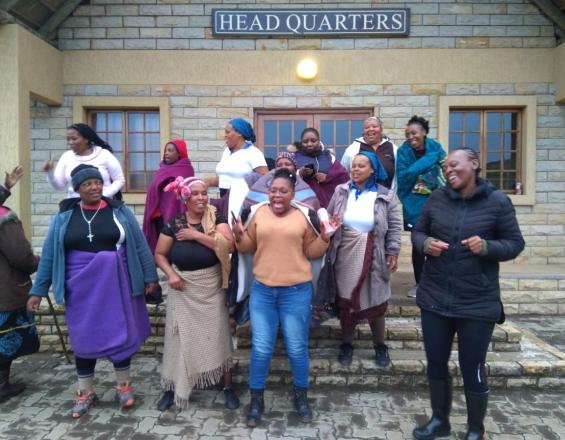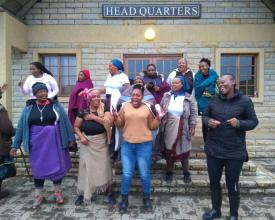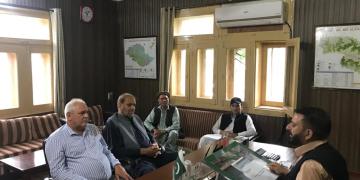
Identifying key biodiversity threats and conservation interventions through management and governance assessment

Sehlabathebe National Park offers significant habitat to a range of unique Afro-Alpine and Sub-Alpine plants, mammals, avifauna, reptiles, amphibians and fish with several internationally recognised rare and threatened endemic species including the Cape- and Bearded vultures, Maloti Minnow and Sehlabathebe Lily. It has a rich cultural heritage with 222 archaeological sites, 97 of which are rock art sites, qualifying the Park as one of the densest rock art concentrations in the world. Systematic assessments identified key biodiversity threats and conservation interventions required for the unique endemic and other plants and animal species found in the park and bufferzone as well as identifying governance issues of the PA and what actions could improve the governance and equity of conservation measures at the site. Following these assessments it is crucial to introduce the third phase of the process which supports planning and implementation of priority actions.
Contexte
Challenges addressed
-
stakeholder collaboration and coordination
-
Insufficient knowledge of Field Rangers
-
Threats to biodiversity and solutions
-
Inadequate Governance structures
-
integrated planning
Emplacement
Traiter
Summary of the process
Both the IMET and SAGE needed stakeholder identification for data collection and analysis. Identifying governance and equity problems is vital for the management of the park and, in conjunction with the management effectiveness assessment, will assist in building on appropriate structures to strengthen collaboration and coordination among stakeholders to assist in planning, monitoring and evaluating PA performance to improve the management and conservation outcomes.
Building Blocks
Identifying facilitators and Assistant facilitators and identification of stakeholders for both trainings
- Sensitization of the Ministry Management on the project for endorsement of the activities as the PA is managed by the government.
- Identifying facilitators who are knowledgeable about the tools with assistance from IUCN as this was the first time the training were conducted and there was no expertise in the country.
- Identifying assistant facilitators from the Ministry to assist with logistics and interpretation. Assistant facilitators, especially youth should also come from members of the community for them to feel free to provide information and feel the need to implement the findings together.
- Stakeholders identification for each workshop training was based on the type of data to be collected. The target participants for SAGE training were mostly the local authorities (Chiefs, local council) and other structures involved in decision making in biodiversity conservation related matters. The target participants for IMET were mostly technical people involved in conservation related issues. Line Ministries were engaged in the training workshop to provide technical expertise on conservation related activities outside PCAs in their respective departments and to agree on the working relations to link conservation inside and outside the PCA
Enabling factors
- Good stakeholder map available allowing informed selection of the relevant people for the assessments
- Endorsement by the Ministry and Park management for support of the processes
Lesson learned
-
Identify possible obstacles and solutions prior to the workshop
-
There is need to invite stakeholders on time to diarise and create time for their participation
-
Sometimes there is need to identify specific people who are involved in projects because they have information that is needed for the process. Ministries sometimes send participants who do not have that information.
-
Considering motivation for participants to keep them throughout the entire period of the workshop (some participants especially community members and the local authorities)
-
Considering interviewing of the decision makers who are not able to attend the workshop at another time to ensure their input is part of the process.
Data collection (IMET and SAGE)
The purpose was to enhance knowledge on the assessment tools and to collect data for informed decisions. For the Intergrated Management Effectiveness Tool (IMET), this involves collecting comprehensive data on the ecological and management attributes of the park and for the Site Assessment on Governance and Equity (SAGE), it involves collecting data on the views and needs of all the stakeholders to facilitate a joint understanding of the governance and the key issues faced in governance of the site. This data is then collectively analysed and provides transparency for all stakeholders present as they have contributed to the data and the analysis.
Enabling factors
-
Description of the assessment tools at the start of the workshop, simplifying terminology into the local language
-
Ensuring that participants understand the type of information required
-
Ensuring active participation from everybody
-
Duration of the workshop - long days discourage people to attend
-
Participants knowledge and active participation
-
Participants availability for all sessions
Lesson learned
-
Lack of data as a result of participants who did not show up can hamper prorgess
-
IMET tool has some challenges when working offline and there is a need to cater for this in remote areas
-
Most participants were not familiar with biodiversity conservation terminologies and some time needs to be added to allow for some explanations first.
-
Close integration with community members is vital - they feel important and provide all the information
-
There is need to probe some participants to get information
-
The tools need coaches knowledgeable about conducting the assessment
-
The assessment tools are giving insight information for improvement of the park management and identifies capacity building needs
Management planning (informed by assessments)
In the case of Sehlabathebe National Park, the analysis of the data and the priority actions for improvement identified during the processes are feeding directly into the management plan for the area. This gives the outputs from the assessment more legitimacy, as they are 1) jointly identified by all relevant stakehodlers and 2) embedded in the formal government processes of managemen planning. The management plan can be used as a tool for resource mobilisation amongst donors and priority actions can then also be monitored through the monitoring of the management plan implementation.
Enabling factors
- Relevant data becomes available through the assessment process
- Analysis of the results can be completed during the workshop
- EXisting planning processes allow formal uptake of results of the assessments
Lesson learned
- Communities expect immediate implementation of the plan, once they ahve shared their views and a joint analysis ahs identified priorities
- The action plan needs resource mobilization for implementation and this should already be considered in the planning of the assessment - to at least implement the first few priorities.
Impacts
-
Stakeholders understand their role and are part of the decision making process.
-
Strengthened collaboration and coordination between stakeholders.
-
Key threats, key species and habitats that need conservation interventions have been identified.
-
Improved Knowledge
-
Development of action plan
-
Ecosystem services have been identified. however there is a need for ecosystem services assessments on the level of exploitation of the services by the community members for sustainable use.
-
The PA is part of the Transfrontier Conservation Area (TFCA) and the project has contributed to the TFCA operational plans.
-
The park is experiencing fires and education programmes have been developed for community members on fire control from households to the wild
Beneficiaries
- Park Management
- Community Members
- UNESCO World Heritage Committee
- SADC TFCA programme
- Ministry of Environment
- Department of Tourism and Culture





